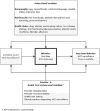Patient-reported barriers are associated with lower hepatocellular carcinoma surveillance rates in patients with cirrhosis
- PMID: 27531684
- PMCID: PMC5568252
- DOI: 10.1002/hep.28770
Patient-reported barriers are associated with lower hepatocellular carcinoma surveillance rates in patients with cirrhosis
Abstract
Over 20% of patients with cirrhosis are nonadherent with hepatocellular carcinoma (HCC) surveillance recommendations; however, few studies have evaluated the impact of patient-level factors on surveillance receipt. We characterized the association between HCC surveillance receipt and patient knowledge, attitudes, and perceived barriers in a racially diverse and socioeconomically disadvantaged cohort of patients with cirrhosis. Patients with cirrhosis followed at a large urban hospital were invited to complete a survey about HCC surveillance between August 2014 and December 2015. Multivariable logistic regression was performed to identify factors associated with HCC surveillance receipt during the 12-month period preceding and 6-month period after survey administration. We achieved a response rate of 71.8% (n = 541 of 753). Patients demonstrated high levels of HCC-related knowledge (summary score, 77.7%); however, 48.6% believed that eating a healthy diet precluded the need for HCC surveillance, and 34.0% believed that HCC surveillance was not necessary if they had a normal physical exam and/or lacked clinical symptoms. Patients expressed worry about developing and dying from HCC, but nearly half (49.9%) of patients reported barriers to receiving HCC surveillance, including difficulty with the scheduling process (30.5%), costs of surveillance testing (25.3%), and transportation difficulties (17.3%). HCC surveillance receipt was significantly higher in patients who knew cirrhosis is a risk factor for developing HCC (odds ratio [OR], 3.09; 95% confidence interval [CI], 1.25-7.62) and significantly lower in those reporting barriers to surveillance (OR, 0.42; 95% CI, 0.25-0.70).
Conclusion: Patients with cirrhosis are knowledgeable and interested in HCC surveillance; however, patient-reported barriers are associated with lower surveillance rates in clinical practice and represent potential intervention targets to improve HCC surveillance effectiveness. (Hepatology 2017;65:875-884).
© 2016 by the American Association for the Study of Liver Diseases.
Conflict of interest statement
Potential conflict of interest: Dr. Singal consults for and is on the speakers’ bureau for Bayer. Dr. Yopp is on the speakers’ bureau for Bayer and received grants from Novartis and Peregrine.
Figures
Comment in
-
Hepatocellular carcinoma surveillance: The road ahead.Hepatology. 2017 Mar;65(3):771-773. doi: 10.1002/hep.28983. Epub 2017 Jan 31. Hepatology. 2017. PMID: 27943335 No abstract available.
-
Patient understanding of hepatocellular carcinoma surveillance.Hepatology. 2017 Jul;66(1):292. doi: 10.1002/hep.29103. Epub 2017 May 26. Hepatology. 2017. PMID: 28195334 No abstract available.
-
Reliability and validity analyses are essential for questionnaire research.Hepatology. 2017 Sep;66(3):1008-1009. doi: 10.1002/hep.29295. Epub 2017 Jul 27. Hepatology. 2017. PMID: 28558127 No abstract available.
References
-
- El-Serag HB, Rudolph KL. Hepatocellular carcinoma: epidemiology and molecular carcinogenesis. Gastroenterology. 2007;132:2557–2576. - PubMed
-
- Singal AG, Marrero JA. Recent advances in the treatment of hepatocellular carcinoma. Curr Opin Gastroenterol. 2010;26:189–195. - PubMed
-
- Ha J, Yan M, Aguilar M, Bhuket T, Tana M, Liu B, et al. Race/ethnicity-specific disparities in cancer incidence, burden of disease, and overall survival among patients with hepatocellular carcinoma in the U. S Cancer. 2016;122:2512–2523. - PubMed
Publication types
MeSH terms
Grants and funding
LinkOut - more resources
Full Text Sources
Other Literature Sources
Medical



